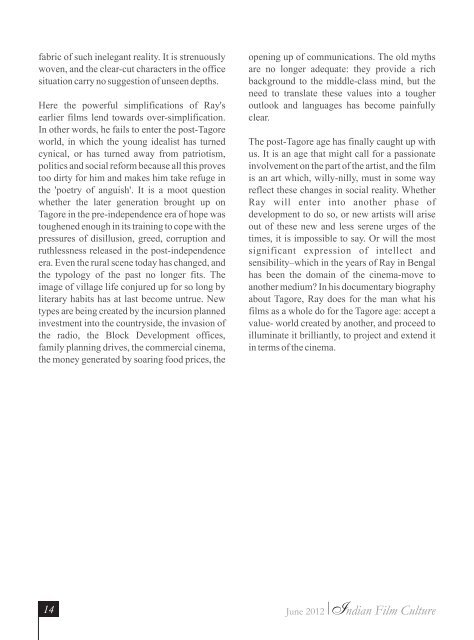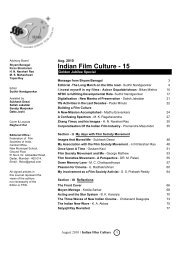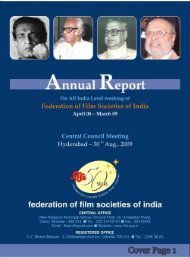Indian Film Culture - 16.cdr - federation of film societies of india
Indian Film Culture - 16.cdr - federation of film societies of india
Indian Film Culture - 16.cdr - federation of film societies of india
You also want an ePaper? Increase the reach of your titles
YUMPU automatically turns print PDFs into web optimized ePapers that Google loves.
fabric <strong>of</strong> such inelegant reality. It is strenuously<br />
woven, and the clear-cut characters in the <strong>of</strong>fice<br />
situation carry no suggestion <strong>of</strong> unseen depths.<br />
Here the powerful simplifications <strong>of</strong> Ray's<br />
earlier <strong>film</strong>s lend towards over-simplification.<br />
In other words, he fails to enter the post-Tagore<br />
world, in which the young idealist has turned<br />
cynical, or has turned away from patriotism,<br />
politics and social reform because all this proves<br />
too dirty for him and makes him take refuge in<br />
the 'poetry <strong>of</strong> anguish'. It is a moot question<br />
whether the later generation brought up on<br />
Tagore in the pre-independence era <strong>of</strong> hope was<br />
toughened enough in its training to cope with the<br />
pressures <strong>of</strong> disillusion, greed, corruption and<br />
ruthlessness released in the post-independence<br />
era. Even the rural scene today has changed, and<br />
the typology <strong>of</strong> the past no longer fits. The<br />
image <strong>of</strong> village life conjured up for so long by<br />
literary habits has at last become untrue. New<br />
types are being created by the incursion planned<br />
investment into the countryside, the invasion <strong>of</strong><br />
the radio, the Block Development <strong>of</strong>fices,<br />
family planning drives, the commercial cinema,<br />
the money generated by soaring food prices, the<br />
14<br />
opening up <strong>of</strong> communications. The old myths<br />
are no longer adequate: they provide a rich<br />
background to the middle-class mind, but the<br />
need to translate these values into a tougher<br />
outlook and languages has become painfully<br />
clear.<br />
The post-Tagore age has finally caught up with<br />
us. It is an age that might call for a passionate<br />
involvement on the part <strong>of</strong> the artist, and the <strong>film</strong><br />
is an art which, willy-nilly, must in some way<br />
reflect these changes in social reality. Whether<br />
Ray will enter into another phase <strong>of</strong><br />
development to do so, or new artists will arise<br />
out <strong>of</strong> these new and less serene urges <strong>of</strong> the<br />
times, it is impossible to say. Or will the most<br />
significant expression <strong>of</strong> intellect and<br />
sensibility–which in the years <strong>of</strong> Ray in Bengal<br />
has been the domain <strong>of</strong> the cinema-move to<br />
another medium? In his documentary biography<br />
about Tagore, Ray does for the man what his<br />
<strong>film</strong>s as a whole do for the Tagore age: accept a<br />
value- world created by another, and proceed to<br />
illuminate it brilliantly, to project and extend it<br />
in terms <strong>of</strong> the cinema.<br />
June 2012<br />
<strong>Indian</strong> <strong>Film</strong> <strong>Culture</strong>





